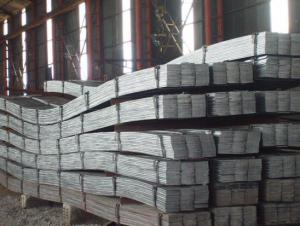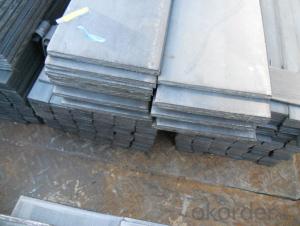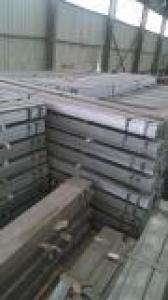Stainless Galvanized Flat Bar of High Quanlity with Leigth 6M/12M
- Loading Port:
- Tianjin
- Payment Terms:
- TT OR LC
- Min Order Qty:
- 50 m.t.
- Supply Capability:
- 1000 m.t./month
OKorder Service Pledge
OKorder Financial Service
You Might Also Like
Product Description:
OKorder is offering Stainless Galvanized Flat Bar of High Quanlity with Leigth 6M/12M at great prices with worldwide shipping. Our supplier is a world-class manufacturer of steel, with our products utilized the world over. OKorder annually supplies products to European, North American and Asian markets. We provide quotations within 24 hours of receiving an inquiry and guarantee competitive prices.
Product Applications:
Stainless Galvanized Flat Bar of High Quanlity with Leigth 6M/12M are ideal for structural applications and are widely used in the construction of buildings and bridges, and the manufacturing, petrochemical, and transportation industries.
Product Advantages:
OKorder's Galvanized Flat Bar of Q235 with Leigth 6M/12M are durable, strong, and resist corrosion.
Main Product Features:
· Premium quality
· Prompt delivery & seaworthy packing (30 days after receiving deposit)
· Corrosion resistance
· Can be recycled and reused
· Mill test certification
· Professional Service
· Competitive pricing
Specifications of Stainless Galvanized Flat Bar of High Quanlity with Leigth 6M/12M
1. Invoicing on theoretical weight or actual weight as customer request
2. Length: 6m, 12m as following table
3. Sizes:
Galvanized Flat Bar Zinc Thickness:15-80μ
Grade: A36, SS400, Q235, Q195
Standard: ASTM, JIS, GB
Thickness:1.5mm-20mm
Width: 10mm-250mm
Width | Thickness | Width | Thickness | Width | Thickness |
(mm) | (mm) | (mm) | (mm) | (mm) | (mm) |
8 | 5-7 | 50 | 5-25 | 200 | 8-40 |
10 | 3-9 | 55 | 5-25 | 220 | 8-40 |
12 | 3-9 | 60 | 5-25 | 250 | 8-40 |
13 | 5-11 | 65 | 5-25 | 260 | 8-40 |
14 | 3-12 | 70 | 5-25 | 270 | 8-40 |
15 | 5-12 | 75 | 5-25 | 280 | 8-40 |
16 | 4-14 | 80 | 6-25 | 290 | 8-40 |
18 | 4-16 | 85 | 6-25 | 300 | 8-40 |
20 | 4-18 | 90 | 6-25 | 310 | 8-40 |
22 | 4-20 | 95 | 6-25 | 320 | 8-40 |
24 | 5-20 | 100 | 6-25 | 330 | 8-40 |
25 | 4-20 | 105 | 6-25 | 340 | 8-40 |
28 | 4-20 | 110 | 6-25 | 350 | 8-40 |
30 | 4-25 | 120 | 7-25 | 360 | 8-40 |
32 | 4-25 | 125 | 7-25 | 370 | 8-40 |
35 | 4-25 | 130 | 8-25 | 380 | 8-40 |
36 | 6-25 | 140 | 8-25 | 390 | 8-40 |
38 | 7-25 | 150 | 8-25 | 400 | 8-40 |
40 | 4-25 | 160 | 8-40 | ||
45 | 4-25 | 180 | 8-40 |
5. Material Specifications:
Production Standard: GB/T 700-2006 | |||||
Grade | Chemical composition (%,max) | ||||
C | Si | Mn | P | S | |
Q195 | 0.12 | 0.30 | 0.50 | 0.035 | 0.040 |
Q235A | 0.22 | 0.35 | 1.40 | 0.045 | 0.050 |
Q235B | 0.20 | 0.35 | 1.40 | 0.045 | 0.045 |
Q235C | 0.17 | 0.35 | 1.40 | 0.040 | 0.040 |
Q235D | 0.17 | 0.35 | 1.40 | 0.035 | 0.035 |
Q235 is similar to ASTMA36,JIS SS400
Usage & Applications of Stainless Galvanized Flat Bar of High Quanlity with Leigth 6M/12M
Widely used for construction,Fabrication , Ship building, Machinery manufacturing, Steel structure
Packaging & Delivery of Galvanized Flat Bar of Q235 with Leigth 6M/12M
1. Packing: it is nude packed in bundles by steel wire rod
2. Bundle weight: not more than 3.5MT for bulk vessel; less than 3 MT for container load
3. Marks:
Color marking: There will be color marking on both end of the bundle for the cargo delivered by bulk vessel. That makes it easily to distinguish at the destination port.
Tag mark: there will be tag mark tied up on the bundles. The information usually including supplier logo and name, product name, made inChina, shipping marks and other information request by the customer.
4. Transportation: the goods are delivered by truck from mill to loading port, the maximum quantity can be loaded is around 40MTs by each truck. If the order quantity cannot reach the full truck loaded, the transportation cost per ton will be little higher than full load.
5. Delivered by container or bulk vessel
Production flow of Stainless Galvanized Flat Bar of High Quanlity with Leigth 6M/12M
The process of hot-dip galvanizing results in a metallurgical bond between zinc and steel with a series of distinct iron-zinc alloys. The resulting coated steel can be used in much the same way as uncoated.
A typical hot-dip galvanizing line operates as follows:
Steel is cleaned using a caustic solution. This removes oil/grease, dirt, and paint.
The caustic cleaning solution is rinsed off.
The steel is pickled in an acidic solution to remove mill scale.
The pickling solution is rinsed off.
A flux, often zinc ammonium chloride is applied to the steel to inhibit oxidation of the cleaned surface upon exposure to air. The flux is allowed to dry on the steel and aids in the process of the liquid zinc wetting and adhering to the steel.
The steel is dipped into the molten zinc bath and held there until the temperature of the steel equilibrates with that of the bath.
The steel is cooled in a quench tank to reduce its temperature and inhibit undesirable reactions of the newly formed coating with the atmosphere.
FAQ:
Q1: Why buy Materials & Equipment from OKorder.com?
A1: All products offered byOKorder.com are carefully selected from China's most reliable manufacturing enterprises. Through its ISO certifications, OKorder.com adheres to the highest standards and a commitment to supply chain safety and customer satisfaction.
Q2: How do we guarantee the quality of our products?
A2: We have established an advanced quality management system which conducts strict quality tests at every step, from raw materials to the final product. At the same time, we provide extensive follow-up service assurances as required.
Q3: How soon can we receive the product after purchase?
A3: Within three days of placing an order, we will begin production. The specific shipping date is dependent upon international and government factors, but is typically 7 to 10 workdays.


- Q: How do you determine the ductility of a steel flat bar?
- The ductility of a steel flat bar can be determined by conducting a tensile test. In this test, a sample of the steel flat bar is subjected to an applied force, causing it to stretch until it eventually breaks. By measuring the elongation of the sample and calculating the percentage reduction in cross-sectional area at the point of fracture, we can determine the ductility of the steel flat bar.
- Q: What is the weight of a steel flat bar?
- The weight of a steel flat bar can vary depending on its dimensions and specific type of steel.
- Q: Can steel flat bars be used in the construction of storage racks or shelves?
- Indeed, in the construction of storage racks or shelves, steel flat bars find their utility. Steel, a robust and long-lasting material, enjoys wide usage in the construction industry. Flat bars offer a solid and secure foundation for storage racks or shelves, guaranteeing their ability to bear substantial loads and endure the trials of time. Moreover, steel flat bars can be effortlessly fused or fastened together to fashion tailored storage solutions that perfectly match particular requirements and spatial constraints. In summary, owing to their strength, durability, and adaptability, steel flat bars constitute a dependable selection for the erection of storage racks or shelves.
- Q: What are the advantages of using steel flat bars?
- There are several advantages of using steel flat bars in various applications. Firstly, steel flat bars offer exceptional strength and durability. Steel is known for its high tensile strength, making it a reliable choice for structural applications. Whether used in construction, manufacturing, or fabrication, steel flat bars can withstand heavy loads and provide long-lasting performance. Additionally, steel flat bars are highly versatile. They can be easily shaped, bent, or cut to suit specific project requirements. This adaptability makes steel flat bars suitable for various applications, including support beams, frames, braces, and brackets. Furthermore, steel flat bars have excellent corrosion resistance. When properly treated and finished, such as with galvanization or painting, steel flat bars can withstand harsh environmental conditions, including exposure to moisture, chemicals, and extreme temperatures. This corrosion resistance ensures the longevity and reliability of steel flat bars, reducing maintenance and replacement costs in the long run. Moreover, steel flat bars offer cost-effectiveness. Steel is a widely available and affordable material, making it a cost-effective option for many industries. Additionally, the durability and long lifespan of steel flat bars result in reduced maintenance and replacement expenses, providing significant cost savings over time. Lastly, steel flat bars are eco-friendly. Steel is a highly recyclable material, allowing for sustainable use and reducing the overall environmental impact. By utilizing steel flat bars in construction and manufacturing processes, companies can contribute to a more sustainable future by reducing waste and conserving natural resources. In summary, the advantages of using steel flat bars include exceptional strength, versatility, corrosion resistance, cost-effectiveness, and eco-friendliness. These characteristics make steel flat bars a preferred choice for a wide range of applications across different industries.
- Q: What are the different methods of cutting steel flat bars?
- There are several different methods of cutting steel flat bars, each with its own advantages and applications. 1. Sawing: One of the most common methods of cutting steel flat bars is using a saw. There are several types of saws that can be used, including band saws, circular saws, and abrasive saws. Band saws are ideal for cutting larger quantities of steel bars quickly and efficiently, while circular saws are more suitable for smaller jobs or cutting through thicker bars. Abrasive saws, also known as cutoff saws, use a rotating abrasive disc to cut through the steel. 2. Shearing: Shearing is another popular method for cutting steel flat bars. It involves using a shear machine that applies a significant amount of force to cut through the material. Shearing is particularly useful for cutting through thick steel bars, as the force applied allows for a clean, straight cut. 3. Plasma cutting: Plasma cutting is a more advanced method that uses a high-velocity jet of ionized gas to melt and cut through the steel. This method is highly precise and allows for intricate shapes and designs to be cut, making it suitable for more complex cutting requirements. 4. Laser cutting: Similar to plasma cutting, laser cutting utilizes a high-powered laser beam to melt and cut through the steel. This method is incredibly accurate and can produce clean, smooth cuts. Laser cutting is often used for cutting thin steel flat bars or for precise, intricate designs. 5. Waterjet cutting: Waterjet cutting utilizes a high-pressure jet of water mixed with abrasive particles to cut through the steel. This method is versatile and can cut through a wide range of materials, including steel. It is particularly useful for cutting through thicker steel bars or for materials that may be sensitive to heat. Overall, the choice of cutting method depends on factors such as the thickness of the steel, the desired precision, and the complexity of the design. Each method has its own advantages and limitations, so it is important to consider these factors when selecting the appropriate cutting method for steel flat bars.
- Q: Can steel flat bars be used as reinforcement in concrete structures?
- Yes, steel flat bars can be used as reinforcement in concrete structures. Steel bars are commonly used in concrete construction to provide strength and durability to the structure. They are placed within the concrete to resist tensile forces and prevent cracking. Steel flat bars are particularly effective in providing increased flexural strength to the concrete, making them suitable for reinforcing beams, slabs, and other structural elements. The flat shape of the bars allows them to be easily embedded within the concrete, ensuring a strong bond between the two materials. Steel flat bars are available in various sizes and grades, allowing for customization based on the specific requirements of the concrete structure.
- Q: What is the density of steel flat bars?
- The density of steel flat bars can vary depending on the specific type of steel being used. On average, the density of steel is around 7.85 grams per cubic centimeter (g/cm³) or 7850 kilograms per cubic meter (kg/m³). However, it is important to note that different grades and alloys of steel can have slightly different densities. Therefore, it is always recommended to refer to the specific material specifications or consult a reliable source for the accurate density of a particular steel flat bar.
- Q: Are steel flat bars suitable for machining or drilling?
- Machining and drilling find steel flat bars to be a suitable option. The strength and durability of steel make it effortlessly moldable, cuttable, and drillable into diverse shapes. Especially, flat bars offer a stable and inflexible surface, enabling meticulous and precise cuts during machining operations. Employing proper tools and techniques, one can effortlessly create holes of various sizes and shapes by drilling steel flat bars. No matter if one aims to make prototypes, construct machinery, or engage in any other endeavor that demands accurate shaping and drilling, steel flat bars prove to be a dependable selection.
- Q: How do you determine the yield strength of a steel flat bar?
- There are several methods available to determine the yield strength of a steel flat bar. One commonly used approach is the tensile test, also known as the tension test. In this test, the steel flat bar is subjected to increasing tensile force until it breaks, and the stress and strain experienced by the steel are measured. To begin the test, a sample flat bar of known dimensions is prepared by cutting it from the steel material. These dimensions are important as they are used to calculate the cross-sectional area of the bar, which is necessary for determining the stress during the test. The tensile test is typically conducted using a universal testing machine. The steel flat bar is securely clamped into the machine, with one end held firmly while the other end is slowly pulled by a hydraulic or mechanical grip. As the bar is subjected to increasing force, the machine measures the elongation or deformation of the bar. The stress and strain experienced by the steel are calculated by dividing the applied force by the cross-sectional area and the change in length by the original length, respectively. By plotting these values on a stress-strain curve, we can analyze the behavior of the steel and identify its yield point. The yield strength of the steel flat bar is determined by identifying the point on the stress-strain curve where there is a significant increase in strain without a proportional increase in stress. This indicates that the steel has entered the yield region and started to deform plastically, surpassing its elastic limit. Once the yield point is determined, the corresponding stress value is recorded as the yield strength of the steel flat bar. This value is usually expressed in units of force per unit area, such as megapascals or pounds per square inch. It is important to bear in mind that the yield strength can vary depending on factors like the composition of the steel, its heat treatment, and any previous mechanical or thermal processing it has undergone. Therefore, it is recommended to conduct multiple tests and average the obtained yield strengths for accurate and reliable results.
- Q: Are steel flat bars corrosion resistant?
- Yes, steel flat bars can be corrosion resistant depending on the type of steel used. Some stainless steel grades, such as 304 and 316, have excellent corrosion resistance due to their high chromium and nickel content. However, carbon steel flat bars are more prone to corrosion and should be protected with coatings or regular maintenance to prevent rust.
Send your message to us
Stainless Galvanized Flat Bar of High Quanlity with Leigth 6M/12M
- Loading Port:
- Tianjin
- Payment Terms:
- TT OR LC
- Min Order Qty:
- 50 m.t.
- Supply Capability:
- 1000 m.t./month
OKorder Service Pledge
OKorder Financial Service
Similar products
Hot products
Hot Searches
Related keywords






























